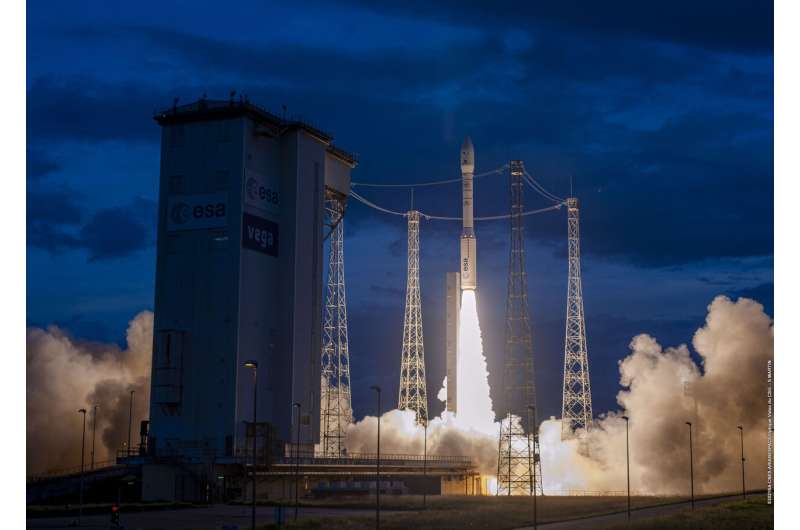
Arianespace announced liftoff of Vega’s twentieth flight from Europe’s Spaceport in French Guiana at 9:27 GMT (10:27 CET; 06:27 local time). Vega delivered three CERES payloads for the French Ministry of the Armed Forces.
Each payload is equipped with high-performance sensors. Flying in formation in low Earth orbit, they will offer all-weather observation, daily revisit frequency, and can collect data enabling the characterisation and location of transmitters.
The payloads were released about 56 minutes into the mission.
Vega took a path to low orbit. Further to the standard stations used on Vega launches, this flight was also tracked by a Naval station and the Santa Maria station in the Azores.
Vega’s upper stage fired a final time to ensure indirect reentry and burn-up high in the atmosphere in compliance with debris regulations to help keep space clean.
The performance requested for this launch was 1548 kg. The three satellites totalled about 1346 kg, with payload adaptors and carrying structures making up the rest.
Vega has been in operation at Europe’s Spaceport since 13 February 2012. It has orbited a total of 111 satellites so far, on single, double and multiple payload missions to multiple orbits: polar and Sun-synchronous, elliptical and equatorial orbit.
Start of transition to more powerful Vega-C
Today’s mission will be followed by Vega’s successor, Vega-C, which will take its first flight in 2022. This starts the transition to Vega-C where for a period, both vehicles will be used.
ESA’s Vega-C, developed and built by prime contractor Avio in Italy, will be able to perform more launches per year than Vega and offers 800 kg more payload capacity to multiple orbits.
Vega-C is more powerful than Vega and has a larger fairing but will keep the same launch cost as Vega. This is partly achieved through sharing the same P120C motor with Ariane 6 to reduce recurring costs and thus reduce the launch cost per kilogram. Vega-C will use a range of payload carriers for different shapes and sizes of payloads from 1 kg to 2300 kg.
“This is the latest Vega success before we welcome Vega-C and new mission opportunities through increased performance and competitiveness. ESA will oversee this transition, build on the accomplishments of Vega and prepare future adaptations for a Vega-E suitable for a rapidly evolving and competitive market, to continue guaranteed access to space for Europe,” commented Renato Lafranconi, Vega programs manager at ESA.
Citation:
Latest Vega launch paves way for Vega-C (2021, November 16)
retrieved 16 November 2021
from https://techxplore.com/news/2021-11-latest-vega-paves-vega-c.html
This document is subject to copyright. Apart from any fair dealing for the purpose of private study or research, no
part may be reproduced without the written permission. The content is provided for information purposes only.
For all the latest Technology News Click Here
For the latest news and updates, follow us on Google News.

